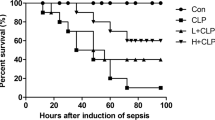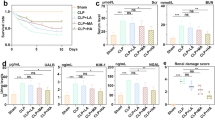Abstract
Acute kidney injury (AKI) is one of the most common complications of sepsis, which largely contributes to the high mortality rate of sepsis. Honokiol, a natural polyphenol from the traditional Chinese herb Magnolia officinalis, is known to possess anti-inflammatory and antioxidant activity. Here, the underlying mechanism of honokiol-induced amelioration of sepsis-associated AKI was analyzed. The expression patterns of oxidative stress moleculars and TLRs-mediated inflammation pathway were examined to identify the response of NRK-52E cells incubated with septic rats’ serum to honokiol. The levels of iNOS, NO, and myeloperoxidase in NRK-52E cells were increased during sepsis, which could be reversed by honokiol. The production of GSH and SOD as in vivo antioxidant was increased after honokiol treatment. The administration of honokiol significantly inhibited TLR2/4/MyD88 signaling pathway in AKI-induced NRK-52E cells. Furthermore, ZnPPIX, the HO-1 inhibitor, weakened honokiol-mediated morphological amelioration, and the reduced level of TNF-α, IL-1β, and IL-6 in kidneys of rats subjected to CLP. Finally, Honokiol was shown to connect with the Nrf2-Keap1 dimensionally. These findings suggest that honokiol plays its protective role on sepsis-associated AKI against oxidative stress and inflammatory signals.






Similar content being viewed by others
References
Goncalves, G.M., D.S. Zamboni, and N.O. Camara. 2010. The role of innate immunity in septic acute kidney injuries. Shock 34 (Suppl 1): 22–26.
Mehta, R.L., J. Bouchard, S.B. Soroko, et al. 2011. Sepsis as a cause and consequence of acute kidney injury: program to improve care in acute renal disease. Intensive Care Medicine 37: 241–224.
Pinto, C.F., M. Watanabe, C.D. da Fonseca, et al. 2012. The sepsis as cause of acute kidney injury: an experimental model. Revista da Escola de Enfermagem da USP 46: 86–90.
Lentini, P., M. de Cal, D. Cruz, A. Chronopoulos, S. Soni, F. Nalesso, M. Zanella, F. Garzotto, A. Brendolan, P. Piccinni, and C. Ronco. 2010. The role of advanced oxidation protein products in intensive care unit patients with acute kidney injury. Journal of Critical Care 25: 605–609.
Okazaki, Y., and A. Matsukawa. 2009. Pathophysiology of sepsis and recent patents on the diagnosis, treatment and prophylaxis for sepsis. Recent Patents on Inflammation & Allergy Drug Discovery 3: 26–32.
Doi, K., A. Leelahavanichkul, P.S. Yuen, and R.A. Star. 2009. Animal models of sepsis and sepsis-induced kidney injury. The Journal of Clinical Investigation 119: 2868–2878.
Liou, K.T., Y.C. Shen, C.F. Chen, C.M. Tsao, and S.K. Tsai. 2003. The anti-inflammatory effect of honokiol on neutrophils: mechanisms in the inhibition of reactive oxygen species production. European Journal of Pharmacology 475: 19–27.
Kim, B.H., and J.Y. Cho. 2008. Anti-inflammatory effect of honokiol is mediated by PI3K/Akt pathway suppression. Acta Pharmacologica Sinica 29: 113–122.
Wang, Y., Z.Z. Zhang, Y. Wu, et al. 2013. Honokiol protects rat hearts against myocardial ischemia reperfusion injury by reducing oxidative stress and inflammation. Experimental and Therapeutic Medicine 5: 315–319.
Weng, T.I., H.Y. Wu, C.W. Kuo, and S.H. Liu. 2011. Honokiol rescues sepsis-associated acute lung injury and lethality via the inhibition of oxidative stress and inflammation. Intensive Care Medicine 37: 533–541.
Yu, Y., M. Li, N. Su, et al. 2016. Honokiol protects against renal ischemia/reperfusion injury via the suppression of oxidative stress, iNOS, inflammation and STAT3 in rats. Molecular Medicine Reports 13: 1353–1360.
Li, N., H. Xie, L. Li, J. Wang, M. Fang, N. Yang, and H. Lin. 2014. Effects of honokiol on sepsis-induced acute kidney injury in an experimental model of sepsis in rats. Inflammation 37: 1191–1199.
Qaisiya, M., Z.C.D. Coda, C. Bellarosa, and C. Tiribelli. 2014. Bilirubin mediated oxidative stress involves antioxidant response activation via Nrf2 pathway. Cellular Signalling 26: 512–520.
Kim, H.S., E.J. Park, S.W. Park, H.J. Kim, and K.C. Chang. 2013. A tetrahydroisoquinoline alkaloid THI-28 reduces LPS-induced HMGB1 and diminishes organ injury in septic mice through p38 and PI3K/Nrf2/HO-1 signals. International Immunopharmacology 17: 684–692.
Hao, E., F. Lang, Y. Chen, H. Zhang, X. Cong, X. Shen, and G. Su. 2013. Resveratrol alleviates endotoxin-induced myocardial toxicity via the Nrf2 transcription factor. PLoS One 8: e69452.
Souza, A.C., R.A. Volpini, M.H. Shimizu, et al. 2012. Erythropoietin prevents sepsis-related acute kidney injury in rats by inhibiting NF-kappaB and upregulating endothelial nitric oxide synthase. American Journal of Physiology. Renal Physiology 302: F1045–F1054.
Parikh, S.M. 2013. Therapeutic targeting of the mitochondrial dysfunction in septic acute kidney injury. Current Opinion in Critical Care 19: 554–559.
Kong, X., R. Thimmulappa, P. Kombairaju, and S. Biswal. 2010. NADPH oxidase-dependent reactive oxygen species mediate amplified TLR4 signaling and sepsis-induced mortality in Nrf2-deficient mice. Journal of Immunology 185: 569–577.
Wu, Z., P. Puigserver, U. Andersson, C. Zhang, G. Adelmant, V. Mootha, A. Troy, S. Cinti, B. Lowell, R.C. Scarpulla, and B.M. Spiegelman. 1999. Mechanisms controlling mitochondrial biogenesis and respiration through the thermogenic coactivator PGC-1. Cell 98: 115–124.
Vilela, F.M., Y.M. Fonseca, F.T. Vicentini, and M.J. Fonseca. 2013. Sunscreen protection against ultraviolet-induced oxidative stress: evaluation of reduced glutathione levels, metalloproteinase secretion, and myeloperoxidase activity. Pharmazie 68: 872–876.
Anatoliotakis, N., S. Deftereos, G. Bouras, G. Giannopoulos, D. Tsounis, C. Angelidis, A. Kaoukis, and C. Stefanadis. 2013. Myeloperoxidase: expressing inflammation and oxidative stress in cardiovascular disease. Current Topics in Medicinal Chemistry 13: 115–138.
Nakazato, T., M. Sagawa, K. Yamato, M. Xian, T. Yamamoto, M. Suematsu, Y. Ikeda, and M. Kizaki. 2007. Myeloperoxidase is a key regulator of oxidative stress mediated apoptosis in myeloid leukemic cells. Clinical Cancer Research 13: 5436–5445.
Heemskerk, S., P. Pickkers, M.P. Bouw, A. Draisma, J. van der Hoeven, W.H. Peters, P. Smits, F.G. Russel, and R. Masereeuw. 2006. Upregulation of renal inducible nitric oxide synthase during human endotoxemia and sepsis is associated with proximal tubule injury. Clinical Journal of the American Society of Nephrology 1: 853–862.
Aksu, U., C. Demirci, and C. Ince. 2011. The pathogenesis of acute kidney injury and the toxic triangle of oxygen, reactive oxygen species and nitric oxide. Contributions to Nephrology 174: 119–128.
Fortin, C.F., P.P. McDonald, T. Fulop, and O. Lesur. 2010. Sepsis, leukocytes, and nitric oxide (NO): an intricate affair. Shock 33: 344–352.
Hu, Z., X. Bian, X. Liu, Y. Zhu, X. Zhang, S. Chen, K. Wang, and Y. Wang. 2013. Honokiol protects brain against ischemia-reperfusion injury in rats through disrupting PSD95-nNOS interaction. Brain Research 1491: 204–212.
Singh, T., and S.K. Katiyar. 2011. Honokiol, “a phytochemical from Magnolia spp., inhibits breast cancer cell migration by targeting nitric oxide and cyclooxygenase-2”. International Journal of Oncology 38: 769–776.
Fang, J.P., Y. Liu, J. Li, W.F. Liao, Y.H. Hu, and K. Ding. 2012. A novel small molecule, HK-156, inhibits lipopolysaccharide-induced activation of NF-kappaB signaling and improves survival in mouse models of sepsis. Acta Pharmacologica Sinica 33: 1204–1216.
O'Sullivan, A.W., J.H. Wang, and H.P. Redmond. 2009. NF-kappaB and p38 MAPK inhibition improve survival in endotoxin shock and in a cecal ligation and puncture model of sepsis in combination with antibiotic therapy. The Journal of Surgical Research 152: 46–53.
Zhao, H., S. Li, H. Zhang, et al. 2015. Saikosaponin A protects against experimental sepsis via inhibition of NOD2-mediated NF-kappaB activation. Experimental and Therapeutic Medicine 10: 823–827.
Thair, S., and J.A. Russell. 2013. Noncanonical nuclear factor kappa B (NF-kappaB) signaling and potential for therapeutics in sepsis. Current Infectious Disease Reports 15: 364–371.
Raspe, C., K. Hocherl, S. Rath, C. Sauvant, and M. Bucher. 2013. NF-kappaB-mediated inverse regulation of fractalkine and CX3CR1 during CLP-induced sepsis. Cytokine 61: 97–103.
Kalakeche, R., T. Hato, G. Rhodes, K.W. Dunn, T.M. el-Achkar, Z. Plotkin, R.M. Sandoval, and P.C. Dagher. 2011. Endotoxin uptake by S1 proximal tubular segment causes oxidative stress in the downstream S2 segment. Journal of the American Society of Nephrology 22: 1505–1516.
Hu, Y.M., M.H. Pai, C.L. Yeh, Y.C. Hou, and S.L. Yeh. 2012. Glutamine administration ameliorates sepsis-induced kidney injury by downregulating the high-mobility group box protein-1-mediated pathway in mice. American Journal of Physiology. Renal Physiology 302: F150–F158.
Li, L., X. Zhang, L. Cui, L. Wang, H. Liu, H. Ji, and Y. du. 2013. Ursolic acid promotes the neuroprotection by activating Nrf2 pathway after cerebral ischemia in mice. Brain Research 1497: 32–39.
Kong, X., R. Thimmulappa, F. Craciun, C. Harvey, A. Singh, P. Kombairaju, S.P. Reddy, D. Remick, and S. Biswal. 2011. Enhancing Nrf2 pathway by disruption of Keap1 in myeloid leukocytes protects against sepsis. American Journal of Respiratory and Critical Care Medicine 184: 928–938.
Wang, F., J. Liu, Y. Ye, X. Zhang, and L. Wan. 2014. Mechanism of cardiac function changes in rat models of Sjogren’s syndrome based on Keap1-Nrf2/ARE signaling pathways. Xi bao yu fen zi mian yi xue za zhi = Chinese journal of cellular and molecular immunology 30: 497–501.
Kensler, T.W., N. Wakabayashi, and S. Biswal. 2007. Cell survival responses to environmental stresses via the Keap1-Nrf2-ARE pathway. Annual Review of Pharmacology and Toxicology 47: 89–116.
Hsu, C.L., Y.L. Wu, G.J. Tang, T.S. Lee, and Y.R. Kou. 2009. Ginkgo biloba extract confers protection from cigarette smoke extract-induced apoptosis in human lung endothelial cells: role of heme oxygenase-1. Pulmonary Pharmacology & Therapeutics 22: 286–296.
Tanaka, Y., J.M. Maher, C. Chen, and C.D. Klaassen. 2007. Hepatic ischemia-reperfusion induces renal heme oxygenase-1 via NF-E2-related factor 2 in rats and mice. Molecular Pharmacology 71: 817–825.
Martinez, V.D., E.A. Vucic, L.A. Pikor, K.L. Thu, R. Hubaux, and W.L. Lam. 2013. Frequent concerted genetic mechanisms disrupt multiple components of the NRF2 inhibitor KEAP1/CUL3/RBX1 E3-ubiquitin ligase complex in thyroid cancer. Molecular Cancer 12: 124.
Hast, B.E., D. Goldfarb, K.M. Mulvaney, M.A. Hast, P.F. Siesser, F. Yan, D.N. Hayes, and M.B. Major. 2013. Major, proteomic analysis of ubiquitin ligase KEAP1 reveals associated proteins that inhibit NRF2 ubiquitination. Cancer Research 73: 2199–2210.
Author information
Authors and Affiliations
Corresponding author
Ethics declarations
Conflicts of Interest
The authors declare that they have no conflict of interest.
Additional information
Publisher’s Note
Springer Nature remains neutral with regard to jurisdictional claims in published maps and institutional affiliations.
Shilin Xia and Hongli Lin contributed equally to this work.
Rights and permissions
About this article
Cite this article
Xia, S., Lin, H., Liu, H. et al. Honokiol Attenuates Sepsis-Associated Acute Kidney Injury via the Inhibition of Oxidative Stress and Inflammation. Inflammation 42, 826–834 (2019). https://doi.org/10.1007/s10753-018-0937-x
Published:
Issue Date:
DOI: https://doi.org/10.1007/s10753-018-0937-x




